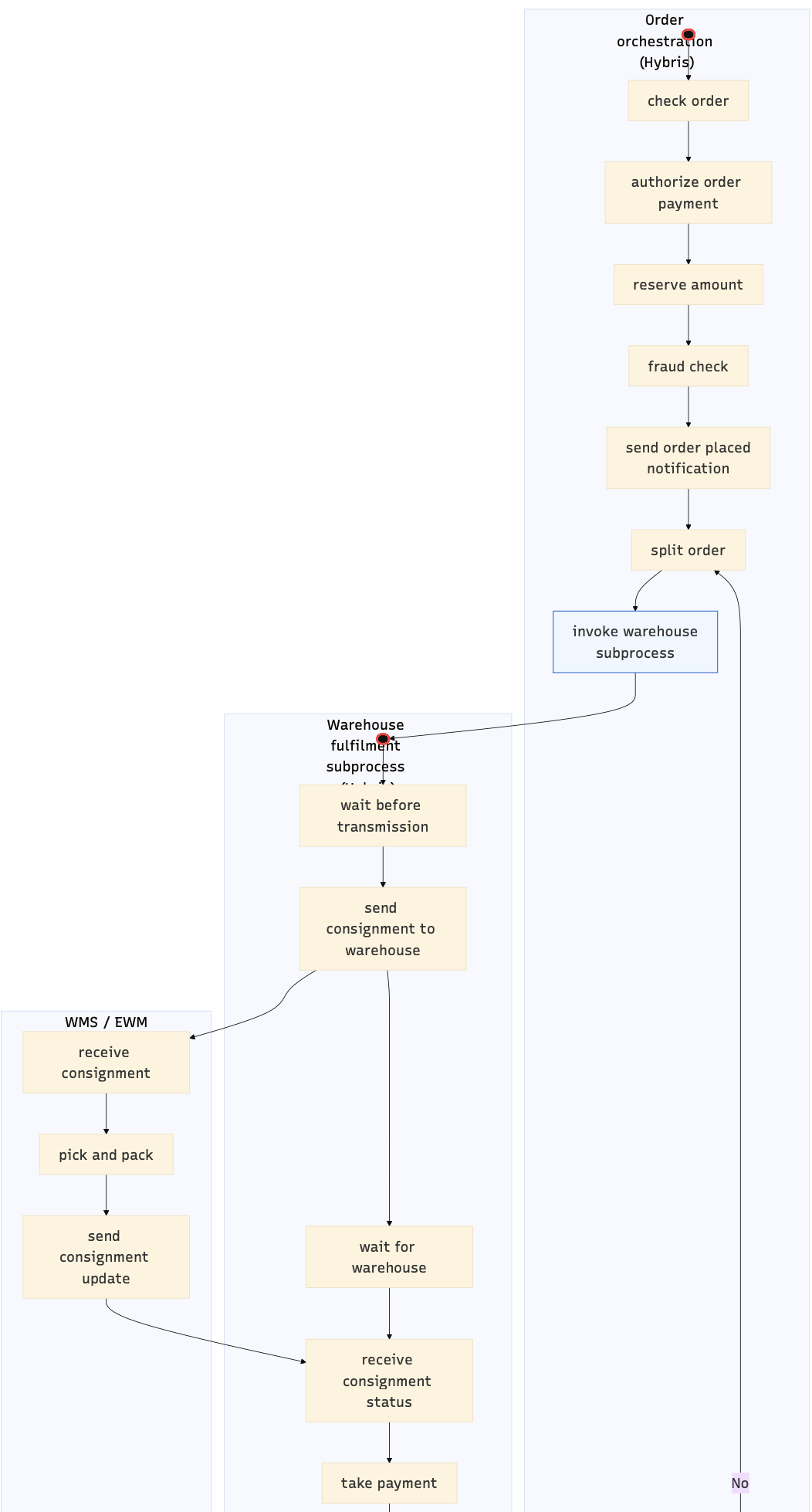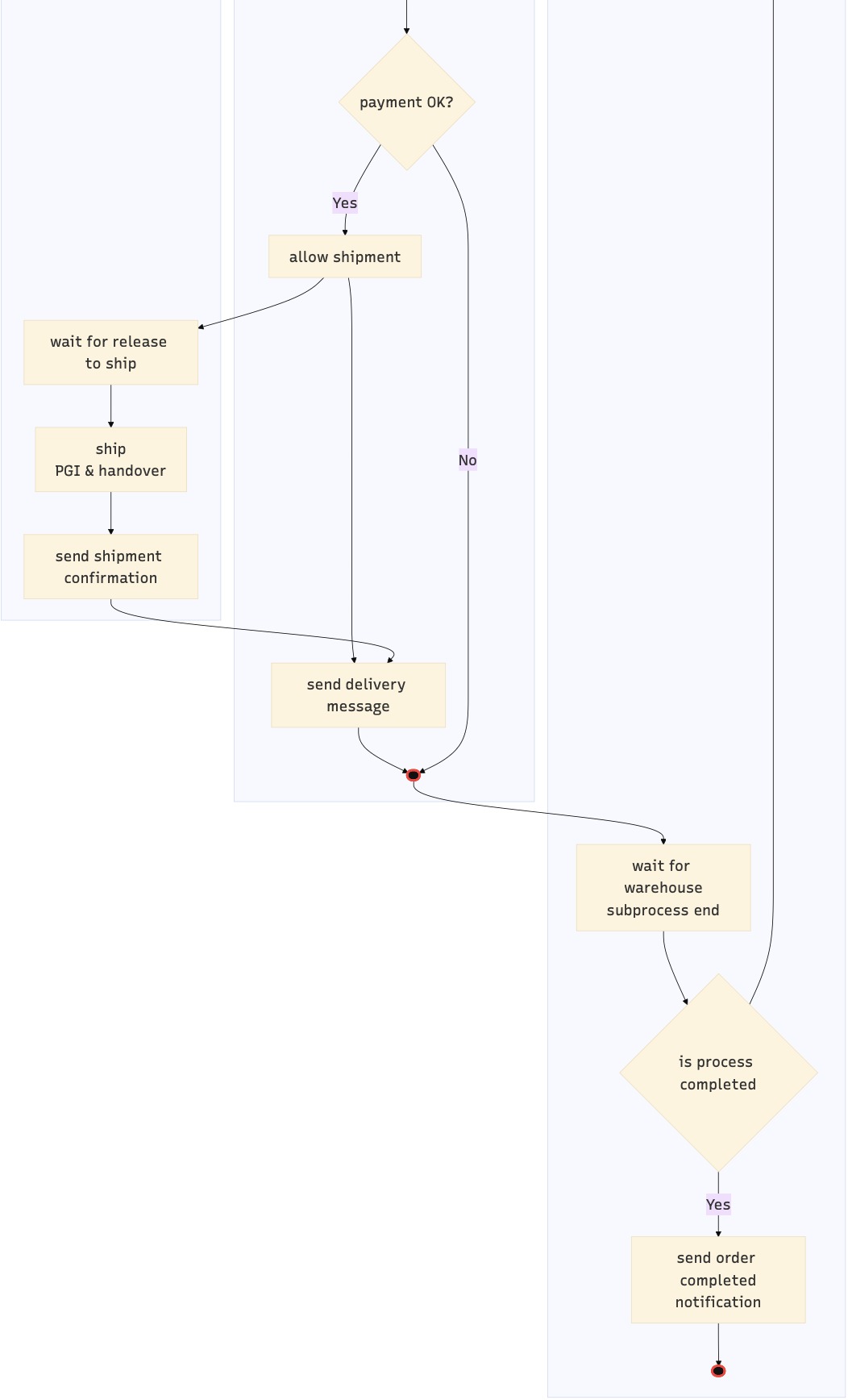Understanding SAP Hybris Order Management and Its Collaboration with WMS (EWM)
1. Why an Order Management System matters
In modern e-commerce, the Order Management System (OMS) in SAP Commerce Cloud (Hybris) orchestrates the complete order lifecycle.
It verifies the order, checks payment authorization, performs fraud checks, splits the order into shipments (consignments), monitors warehouse updates, and notifies the customer when the order is complete.
Rather than being a simple order repository, the OMS acts as the central orchestrator that coordinates multiple business processes and systems — ERP, payment service providers (PSPs), and the warehouse management system (WMS).
2. The “PlaceOrder” process – the orchestration brain
The PlaceOrder process in Hybris defines the top-level workflow for any customer order.


Each step is an executable Spring bean defined in an XML process file managed by the Hybris Process Engine.
Key steps in the PlaceOrder process
Check order – validates the order content and pricing.
Authorize order payment – sends an authorization request to the connected Payment Service Provider (PSP).
Reserve amount – reserves the authorized funds to prevent over-spending or duplicate capture.
Fraud check – runs automatic or manual fraud verification.
Send order placed notification – confirms to both customer and system that the order is accepted.
Split order – divides the order into one or more consignments based on stock, location, or warehouse rules.
Invoke warehouse subprocess – launches one Consignment Fulfilment Subprocess per consignment.
Wait for warehouse subprocess end – pauses the main process until all consignments are processed.
Is process completed? – checks whether all consignments are finished.
Send order completed notification – final confirmation that the overall order has been fulfilled.
Each of these steps corresponds to a node in the XML definition and transitions to the next step according to business outcomes (OK, NOK, ERROR, etc.).
3. The “Consignment Fulfilment” subprocess – the operational arm
Every consignment triggers its own Consignment Fulfilment Subprocess, which handles the detailed interaction between the OMS and the warehouse (WMS/EWM).
Main steps in the fulfilment subprocess
Wait before transmission – optional delay or batch condition before sending to WMS.
Send consignment to warehouse – triggers the interface (API or IDoc) toward the warehouse.
Wait for warehouse – waits for a warehouse event confirming receipt.
Receive consignment status – interprets feedback (OK, PARTIAL, CANCEL, ERROR).
Take payment – captures payment when fulfilment is confirmed.
Allow shipment – sends the “release to ship” signal to WMS.
Send delivery message – notifies delivery or completion to ERP or customer.
Each consignment runs independently, allowing Hybris to manage parallel fulfilments for multi-warehouse or split-order scenarios.
4. How the OMS collaborates with WMS (EWM)
The collaboration between Hybris OMS and the warehouse is event-driven and asynchronous.
The systems exchange messages (often via SAP Cloud Integration or CPI) to keep the order and stock states synchronized.
Typical message flow
Hybris → WMS: Send consignment to warehouse
WMS → Hybris: Acknowledgment (received)
WMS → Hybris: Consignment update (picking, packing)
Hybris → WMS: Release to ship (allow shipment)
WMS → Hybris: Shipment confirmation (PGI, dispatch)
Hybris → ERP / Customer: Delivery message and notification
This handshake ensures the consistency of inventory, billing, and customer communication across systems.
5. Payment orchestration and PSP interaction
Hybris integrates with external Payment Service Providers (PSPs) such as Adyen, Stripe, Worldpay, CyberSource, and PayPal.
These providers handle the secure card authorization and capture operations.
Typical payment flow
Authorize order payment – Hybris requests authorization through the PSP API.
Reserve amount – funds are held on the customer’s account.
Take payment – the PSP captures the payment once the warehouse confirms “ready to ship”.
Webhooks – the PSP sends callbacks to Hybris with the authorization or capture status.
This design ensures that payment is only captured when the goods are physically ready for dispatch, aligning financial and operational workflows.
6. What happens inside the WMS (EWM)
On the warehouse side, the process follows its own physical fulfilment steps:
Receive consignment – create an Outbound Delivery Order (ODO).
Pick and pack – physical preparation of items.
Send consignment update – inform Hybris of progress.
Wait for release to ship – hold until OMS sends approval.
Ship (PGI and handover) – confirm goods issue and dispatch.
Send shipment confirmation – return delivery data to Hybris.
The WMS focuses on execution, while Hybris remains the source of truth for business states and payment logic.
7. Combined orchestration view
Together, the Hybris OMS and the WMS form a cohesive three-layer architecture:
Hybris OMS (PlaceOrder)
Global orchestration, payment and fraud control, notifications.
Hybris Fulfilment Subprocess
Manages the consignment lifecycle and WMS communication.
WMS / EWM
Physical execution: stock movement, picking, packing, and shipping.
This structure allows scalability, auditability, and reliability across multiple warehouses or sales channels.
8. Key takeaways
Hybris acts as the business orchestrator, handling state, payment, and event correlation.
The WMS handles physical execution and stock accuracy.
The integration between both is asynchronous and event-driven, enabling parallel fulfilment.
Hybris’s Process Engine makes it possible to model these flows declaratively in XML while still allowing custom extensions in Java.
When combined with SAP EWM, the solution provides a full end-to-end fulfilment backbone, from order validation to delivery.
9. Conclusion
SAP Commerce Cloud’s OMS, based on the Hybris Process Engine, offers a robust foundation for orchestrating orders across multiple systems.
Its ability to delegate execution to a WMS like SAP EWM while maintaining end-to-end control over payments, status, and notifications makes it one of the most flexible fulfilment solutions in enterprise e-commerce.